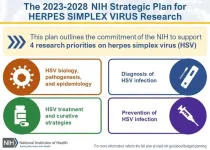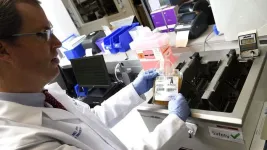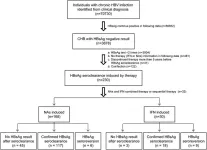(Press-News.org) Researchers in the University of Delaware College of Health Sciences Department of Medical and Molecular Sciences are playing a pivotal role on the global health stage as they investigate the most common sexually transmitted infection (STI) in the world.
Centers for Disease Control statistics show that 79 million Americans have human papillomavirus (HPV). With 14 million new infections each year, 80% of women will get at least one type of HPV at some point in their lifetime, according to the Office on Women’s Health in the U.S. Department of Health and Human Services. Several strains of HPV cause cervical cancer, which is the third most common cancer in women and the second most frequent cause of cancer-related death globally.
New research out of UD’s Department of Medical and Molecular Sciences (MMSC) confirmed 25 different types of HPV prevalent in Nigeria. About half of those types of HPV cause cancer, while others cause STIs like genital warts, according to lead investigator Sam Biswas, professor of medical and molecular sciences. The research was recently published in Virology Journal.
The discovery was made possible through an international collaboration between UD’s MMSC Department and two regional Nigerian hospitals spawned by UD alumna Ngozi Dom-Chima. Dom-Chima graduated with her doctorate in medical sciences in May and now works as a research scientist at Incyte.
“There’s a high cervical cancer rate in Nigeria, and there’s not much research on HPV variants,” Dom-Chima said. “Now that the world has become global, people are migrating and carrying diseases. The variants that are circulating in Nigeria, while they’re not really seen here in the U.S., they’ll eventually get here.”
Dom-Chima was born in Nigeria and helped create crucial trust between UD and local Nigerian hospital systems so they would participate in this important global health research.
“When working in global health, before entering a community to talk, evaluate, or start a program, you must intimately know the community you’re working with,” Dom-Chima said. “If they don’t participate in our study, there won’t be any results. Being Nigerian, I was able to reassure them that we wouldn’t mishandle patient samples and that we’d treat them with respect.”
Together, Dom-Chima and Biswas obtained 90 cervical samples and spent six months processing samples using next-generation DNA sequencing to identify multiple HPV types in samples. Type-specific PCR analysis was then used to verify the HPV types circulating in Nigeria. Their research found strikingly high rates of multiple HPV infections in most patients, with as many as nine HPV types identified in a single sample.
Their discovery of 25 prevalent strains of HPV in Nigeria underscores the need for more region-specific vaccines. The leading HPV vaccine, Gardasil-9, only protects against nine cancer-causing types of the virus that are prevalent in the U.S. Just six of the 25 types of HPV circulating in Nigeria are prevented by that vaccine.
“While the vaccine is still very effective, it’s not enough for a country like Nigeria,” Biswas said. “We must come up with a vaccine that’s specific to the strains circulating in certain countries.”
Dom-Chima hopes pharmaceutical companies are paying attention.
“Pharmaceutical companies must realize there’s no one-size-fits-all approach when it comes to HPV vaccines,” Dom-Chima said. “They need to look at data from different countries and develop region-specific effective vaccines since the ones we have don’t cover most of the types of HPV that are prevalent in Nigeria right now.”
But vaccine development is costly and that can serve as a roadblock for poorer countries like Nigeria.
“Nigeria doesn’t have the money to provide vaccinations to all women,” Biswas said. “With advanced healthcare systems in the U.S. and Europe, we have a stronger ability to combat HPV, cervical cancer, and cancer deaths, but countries like Nigeria don’t have that ability. Even though we have many different types of HPV in the U.S., the death rate from cervical cancer is much lower. Infections and cancers that can be more readily treated in the U.S., could lead to someone dying every day in Nigeria.”
Access to vaccines in Nigeria is also limited. Globally, just one in eight girls is vaccinated against HPV, according to the United Nations Children’s Fund (UNICEF). UNICEF introduced the HPV vaccine to 52 countries, including seven countries, for the first time this year. Nigeria was one of those countries.
Until region-specific vaccines are developed and access to those vaccines is expanded, HPV continues to silently spread and silently kill. Another piece of the problem — populations of the world aren’t testing for the STI.
“Laboratory tests for HPV only test for a limited number of high- and low-risk variants,” said Esther Biswas-Fiss, professor and chair of the MMSC Department and a co-investigator on the research. “Hybrid capture, a test commonly used in women’s healthcare, recognizes 13 HPV types. Like the vaccine, it’s designed to detect strains that are found to be prevalent in the U.S., but it won’t pick up some of the other strains that the sensitive methods used in the Biswas lab have identified.”
While annual pap smears during routine gynecological visits detect HPV in women, for half the population — men — there is no approved test for HPV.
“In the U.S., many are unaware of the significance of the problem,” Biswas-Fiss said. “HPV is a slow-moving virus that doesn’t distinguish between men and women. Previous research tied tobacco and alcohol consumption to head and neck cancers, but now HPV is the leading cause of head and neck cancer in the U.S.”
Head and neck cancers include cancers of the mouth, throat, nose, sinuses, salivary glands and middle ear.
Biswas aims to expand his research to study HPV in other countries, including the U.S.; however, obtaining patient consent to get samples can be challenging due to HIPPA. He hopes his research inspires other countries to conduct their own HPV research.
“Scientists in Africa, Asia, and South America should do similar studies to identify which types of HPV are prevalent there to aid in region-specific vaccine development,” Biswas said. “The United Nations could also step in and try to solve this problem.”
Ongoing research in the Biswas lab also focuses on the biology of HPV. A better understanding of the biology of the virus could lead to treatment or even, someday, a cure.
“We’ve spent centuries focusing on how to kill bacteria, but viruses as infectious agents have not received comparable attention, and they can be equally as deadly,” Biswas-Fiss said. “Right now, we can only test people and vaccinate them in hopes of preventing HPV. By better understanding the fundamental biology of HPV, we can develop antiviral drugs to fight back against the cancer-causing virus.”
END
Leading the way in global STI research
New study shows 25 HPV types circulating in Nigeria, necessitating new region-specific vaccines
2023-09-19
ELSE PRESS RELEASES FROM THIS DATE:
NIH releases strategic plan for research on herpes simplex virus 1 and 2
2023-09-19
WHAT:
In response to the persistent health challenges of herpes simplex virus 1 (HSV-1) and HSV-2, today the National Institutes of Health released the Strategic Plan for Herpes Simplex Virus Research. An NIH-wide HSV Working Group developed the plan, informed by feedback from more than 100 representatives of the research and advocacy communities and interested public stakeholders. The plan outlines an HSV research framework with four strategic priorities: improving fundamental knowledge of HSV biology, pathogenesis, and epidemiology; accelerating research to improve HSV diagnosis; improving strategies to treat HSV while seeking a curative therapeutic; and, advancing research ...
Early convalescent plasma use — helpful in avoiding severe COVID — also may lower long COVID risk
2023-09-19
Findings from a nationwide, multicenter study led by Johns Hopkins Medicine and the Johns Hopkins Bloomberg School of Public Health suggest that patients with COVID-19 have less chance of developing post-COVID conditions — commonly known as long COVID — if they receive early treatment with plasma from convalescent (recovered) COVID patients that contain antibodies against SARS-CoV-2, the virus that causes COVID-19.
The new research, first posted online today in mBio, a journal from the American Society for Microbiology, is a follow-up investigation to the 2021 clinical trial that showed convalescent plasma ...
Machine learning analysis of research citations highlights importance of federal funding for basic scientific research
2023-09-19
Biomedical research aimed at improving human health is particularly reliant on publicly funded basic science, according to a new analysis boosted by artificial intelligence.
“What we found is that even though research funded by the National Institutes of Health makes up 10% of published scientific literature, those published papers account for about 30% of the substantive research — the important contributions supporting even more new scientific findings — cited by further clinical research ...
Fast-track strain engineering for speedy biomanufacturing
2023-09-19
Using engineered microbes as microscopic factories has given the world steady sources of life-saving drugs, revolutionized the food industry, and allowed us to make sustainable versions of valuable chemicals previously made from petroleum.
But behind each biomanufactured product on the market today is the investment of years of work and many millions of dollars in research and development funding. Berkeley Lab scientists want to help the burgeoning industry reach new heights by accelerating and streamlining the process of engineering microbes to produce important compounds with ...
Firearm violence exposure in Black and American Indian/Alaska Native communities linked to poorer health
2023-09-19
There is a widening health disparity among Black, American Indian and Alaska Native adults exposed to gun violence, according to Rutgers researchers who say these communities have more mental and physical health issues because they witness or are victimized at a higher rate.
In a new study published in Health Affairs Scholar, 3,015 Black and 527 American Indian/Alaska Native (AI/AN) adults residing in the United States were surveyed between April and May 2023.
Participants were asked whether they were threatened with a firearm, shot with a firearm, had a family or friend shot with a firearm, or witnessed or heard about a shooting. The results found that these ...
New evidence indicates vitiligo-associated autoimmunity may contribute to reduced morbidity and mortality risk
2023-09-19
Philadelphia, September 19, 2023 – According to a new study comparing patients with and without vitiligo in South Korea, patients with vitiligo were associated with a 25% decreased risk of mortality compared with controls. This suggests that vitiligo-associated autoimmunity may play a role in reducing morbidity and mortality. The results appear in the Journal of Investigative Dermatology, published by Elsevier.
Previous studies have documented a reduced risk of cancer in patients with vitiligo, however, there has been limited research on the relationship between vitiligo-associated autoimmunity and the risk of morbidity and mortality ...
Eurosceptics more likely to think of the EU as less democratic than it is, study shows
2023-09-19
A significant share of voters see the EU as less democratic than it really is and believe the European Commission can steamroll its member states, a new study shows.
The research shows that key channels of legitimation in the EU are not well known by the citizens of large member states. Whether people see themselves only as citizens of their nation, or simultaneously as a European, is linked to what they believe about the EU.
A substantial share of EU voters who took part in the study believed that the members of the European Parliament are not directly elected. Many assumed the European Parliament is unimportant for decision ...
Poor water, sanitation, and hygiene in low-income countries may help fuel the emergence of deadly pathogens
2023-09-19
A new study suggests that Escherichia coli and other disease-causing microbes are passing easily between humans and animals in Cambodia, a country where clean water, sanitation and hygienic controls are lacking in many regions. The continuous exchange, along with unregulated antibiotic use, leads to the emergence and spread of drug-resistant E. coli, the authors say.
Maya Nadimpalli, a scientific collaborator at the Antibiotic Research Action Center at the George Washington University and her international colleagues, conducted the research in Phnom Penh, an urban area where humans and animals are often living in close proximity without clean water or other ...
Durability of hepatitis b surface antigen seroclearance studied in real-world data from electronic health records
2023-09-19
In a study published in the journal Genes & Diseases, researchers from The Second Affiliated Hospital of Chongqing Medical University analyzed data from an extensive dataset comprising over 70,000 HBsAg-positive individuals at The Second Affiliated Hospital of Chongqing Medical University. They compared two groups: those achieving HBsAg seroclearance through NAs monotherapy (168 patients) and those through IFN monotherapy (30 patients). NAs monotherapy patients were older, with a higher proportion achieving HBsAg seroclearance during ...
Tiny sea creatures reveal the ancient origins of neurons
2023-09-19
A study in the journal Cell sheds new light on the evolution of neurons, focusing on the placozoans, a millimetre-sized marine animal. Researchers at the Centre for Genomic Regulation in Barcelona find evidence that specialized secretory cells found in these unique and ancient creatures may have given rise to neurons in more complex animals.
Placozoans are tiny animals, around the size of a large grain of sand, which graze on algae and microbes living on the surface of rocks and other substrates found in shallow, warm seas. The blob-like and pancake-shaped creatures are so simple that they live without any body parts or organs. These animals, thought to have ...
LAST 30 PRESS RELEASES:
Automatic label checking: The missing step in making reliable medical AI
Low daily alcohol intake linked to 50% heightened mouth cancer risk in India
American Meteorological Society announces Rick Spinrad as 2026 President-Elect
Biomass-based carbon capture spotlighted in newly released global climate webinar recording
Illuminating invisible nano pollutants: advanced bioimaging tracks the full journey of emerging nanoscale contaminants in living systems
How does age affect recovery from spinal cord injury?
Novel AI tool offers prognosis for patients with head and neck cancer
Fathers’ microplastic exposure tied to their children’s metabolic problems
Research validates laboratory model for studying high-grade serous ovarian cancer
SIR 2026 delivers transformative breakthroughs in minimally invasive medicine to improve patient care
Stem Cell Reports most downloaded papers of 2025 highlight the breadth and impact of stem cell research
Oxford-led study estimates NHS spends around 3% of its primary and secondary care budget on the health impacts of heat and cold in England
A researcher’s long quest leads to a smart composite breakthrough
Urban wild bees act as “microbial sensors” of city health.
New study finds where you live affects recovery after a hip fracture
Forecasting the impact of fully automated vehicle adoption on US road traffic injuries
Alcohol-related hospitalizations from 2016 to 2022
Semaglutide and hospitalizations in patients with obesity and established cardiovascular disease
Researchers ‘listen in’ to embryo-mother interactions during implantation using a culture system replicating the womb lining
How changing your diet could help save the world
How to make AI truly scalable and reliable for real-time traffic assignment?
Beyond fragmented markets: A new framework for efficient and stable ride-pooling
Can shape priors make road perception more reliable for autonomous driving?
AI tracks nearly 100 years of aging research, revealing key trends and gaps
Innovative techniques enable Italy’s first imaging of individual trapped atoms
KIER successfully develops Korea-made “calibration thermoelectric module” for measuring thermoelectric device performance
Diversifying US Midwest farming for stability and resilience
Emphasizing immigrants’ deservingness shifts attitudes
Japanese eels, climate change, and river temperature
Pusan National University researchers discover faster, smarter heat treatment for lightweight magnesium metals
[Press-News.org] Leading the way in global STI researchNew study shows 25 HPV types circulating in Nigeria, necessitating new region-specific vaccines







